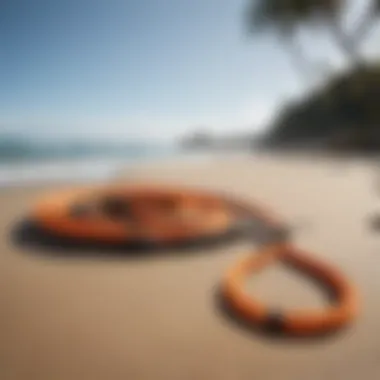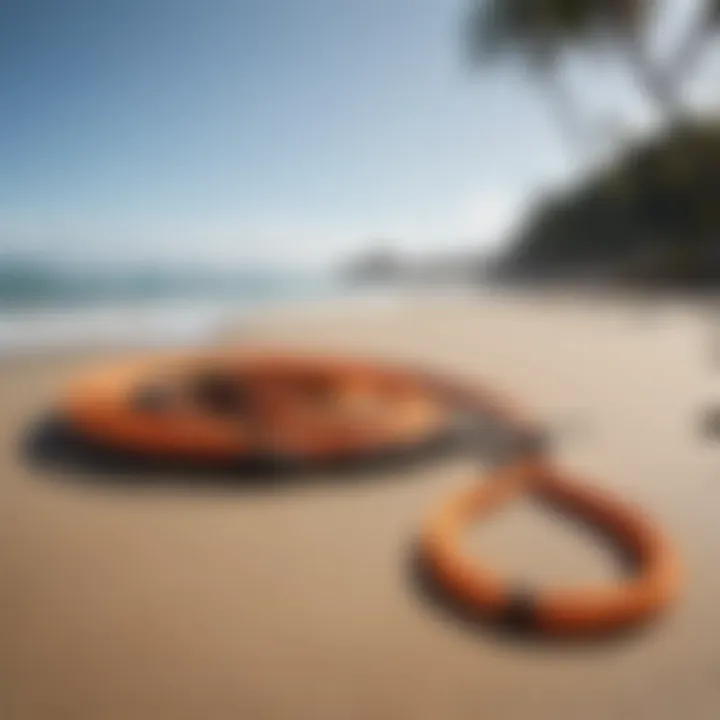Understanding Surf Leashes: Safety and Performance Insights


Intro
Surf leashes are more than just a simple piece of cord connecting a surfer’s ankle to their board; they serve as an essential safety tool for anyone who enjoys the waves. The significance of these leashes is often overlooked by newcomers, yet they play a vital role in ensuring safety and enabling optimal performance in the water. As a surfer, the last thing you want is to lose your board during a wipeout. Not only could that lead to a long swim back, but it could also pose a danger to others in the water.
In this guide, we will peel back the layers of surf leashes, examining their construction, design, and the various factors that come into play when selecting the right one. From the materials used to the essential features, we aim to provide a thorough understanding for both novices and seasoned surfers alike. Moreover, we will discuss the evolution of surf leash technology and how best practices in maintenance can ensure they last, giving surfers peace of mind while catching waves.
Techniques and Skills
Understanding the role of surf leashes can significantly enhance a surfer's experience. Let's dive into some key aspects that every surfer, regardless of skill level, should be familiar with.
Essential Techniques for Beginners
- Choosing the Right Size: One of the first things to master is selecting a leash that corresponds with your board size and type. Generally, for shortboards, the leash length should be about the same length as the board, while longboards may require a leash that is longer.
- Securing the Leash: It seems simple, right? But ensuring the leash is secured properly to your ankle can make a world of difference. A loose leash can slip off or become tangled during your ride, leading to potential hazards.
- Post-Wipeout Safety: After a fall, knowing how to manage your leash helps; hold onto your board as it acts as a buoy in choppy waters. If the leash gets tangled, attempt to untangle it calmly to avoid panic and focused on returning to your board.
Advanced Skills for Experienced Watersport Enthusiasts
For experienced surfers, there are some more nuanced skills related to surf leashes that can improve performance and safety:
- Leash Length Management: Adapting leash length depending on the surf condition becomes crucial. A longer leash might give more freedom in bigger waves, but more prone to tangling.
- Leash Connection Techniques: Some advanced surfers choose to customize their leash connections for specific surf conditions. Using a double swivel can reduce tangling, a necessity in more aggressive surf scenarios.
- Understanding Wear and Tear: Experienced surfers should develop the ability to identify signs of wear on their leash. Regularly inspect for frays, kinks, or weak spots that could snap under pressure, potentially risking safety and performance.
Equipment and Gear
Must-Have Gear for Each Watersport
When it comes to surfing, a few core items are vital. Here are the essentials:
- Surfboard: The fundamental piece of gear, choose the one that suits your style and skill level.
- Wetsuit: For colder waters, a good wetsuit will keep you warm and comfortable.
- Surf Leash: As discussed, this is key for safety.
- Wax: To ensure your grip on the board is solid, appropriate wax is important.
Tips for Selecting the Right Equipment
When purchasing equipment, consider the following:
- Research and Reviews: Before making any purchases, it’s wise to read reviews or talk to experienced surfers.
- Trial and Fit: Whenever possible, try items like wetsuits or leashes to find a comfortable fit.
- Budget vs. Quality: While it’s tempting to go for the cheapest options, investing in higher-quality gear can save money in the long run due to durability.
"Investing in the right gear today can save you countless headaches tomorrow—worn-out equipment could lead to mishaps in the water."
Maintaining your gear, particularly your leashes, should always be a priority. Regular checks and replacements when necessary can make your time on the water far more enjoyable.
Preface to Surf Leashes
When it comes to the world of surfing, the surf leash stands as a silent guardian, often overlooked yet essential for both safety and performance. The introduction of surf leashes has revolutionized how surfers interact with the waves. These unassuming cords tether the board to the rider, ensuring that in the chaos of crashing waves, the board doesn’t drift away, adding a crucial layer to the experience.
A surf leash isn't just a piece of equipment; it represents a balance between freedom and control. Without it, the surfing experience can quickly become frustrating, especially for those learning the ropes.
Defining Surf Leashes
A surf leash typically consists of a cord made from durable materials, fixed to the tail of a surfboard with a series of knots and often linked to an ankle strap for security. This may sound simple, yet this accessory plays a pivotal role in ensuring that surfers don’t lose their boards in the water. The basic structure includes a urethane or nylon cord, which is designed to stretch slightly, absorbing shock during wipeouts.
Surfers can find various lengths and thicknesses available, catering specifically to different surfing styles and board types. For instance, a standard leash is designed for most shortboards, while longer leashes may cater to bigger boards such as longboards. The correct leash can mean the difference between a smooth ride and a hectic day chasing a runaway board.
The Role of Surf Leashes in Surfing
Surf leashes serve multiple roles that significantly enhance the surfing experience. First and foremost, they keep your board close by, reducing the risk of it colliding with other surfers or getting stranded in unpredictable swell. Imagine the panic when a wave sends you tumbling, and your board vanishes into the foam – that’s where the leash comes into play. It acts like a lifeline, preventing potential damage and ensuring the board remains within an easy reach.
Another vital aspect is safety. If a board gets loose in a crowded lineup, it can become a hazard to others. The leash minimizes that risk. A quick think about the consequences reveals the importance: a runaway board can strike another surfer, causing injury and chaos in an otherwise enjoyable environment.
Additionally, many surf leashes now include safety features like swivel mechanisms that prevent tangling, allowing for a smoother experience during those gnarly rides. This forward-thinking design caters not just to convenience but enhances the overall safety of the surfing community.
In summary, understanding surf leashes is critical for anyone serious about surfing. They not only ensure your board stays close but also play an essential role in promoting safety in the lineup. Taking the time to choose the right leash could very well lead to a hassle-free surf session, leaving you to focus on the joy of riding waves.
Types of Surf Leashes
Understanding the various types of surf leashes is essential for any surfer aiming to optimize their performance in the water. Each type serves a specific purpose and comes with its own set of characteristics tailored to different surfing conditions. By selecting the right leash, surfers can ensure safety, efficiency, and a more enjoyable experience in the waves. Below, we will delve into the common types of surf leashes available on the market, helping you make an informed choice.
Standard Leashes
Standard leashes, often hailed as the backbone of surf accessories, are designed to meet the needs of most surfers. Typically made from durable materials like urethane, they range in thickness and length to accommodate varying styles. The hallmark of a standard leash is its versatility; it suits everything from mellow beach breaks to more challenging surf spots.


When choosing a standard leash, consider the length of your board. A general rule of thumb is to match the leash length with the board’s length. For example, if you are riding a 6’0" shortboard, a 6’0" leash would generally do the trick. These leashes often come with a padded cuff for comfort, and many include a swivel system, helping to prevent tangles during use.
Wider Leashes for Big Wave Surfing
When it comes to tackling the massive swells, wider leashes emerge as a lifeline for serious surfers. These leashes are typically thicker and made using stronger materials, as they’re built to withstand the intense forces of big waves. For instance, surfing spots like Jaws in Hawaii or Teahupo'o in Tahiti require leashes that can endure significant stress during wipeouts.
Additionally, wider leashes often have a longer length, providing more maneuverability in the turbulent water. A thicker leash helps to minimize the risk of breakage, ensuring a connection between the surfer and their board, even in the most chaotic of conditions. However, this added strength comes with a trade-off; wider leashes are often bulkier, which could impede movement slightly. Still, for the thrill-seeker comfortable with larger surf, these leashes are indispensable.
Shortboard vs Longboard Leashes
When it comes to shortboards and longboards, the choice of leash can drastically impact performance. Shortboard leashes tend to be shorter—typically around 6 to 8 feet—carefully constructed to offer minimal drag while maximizing responsiveness. Surfers riding shortboards prioritize quick turns and agility, necessitating a leash that doesn’t hinder their movements.
In contrast, longboard leashes are usually longer and thicker, often ranging from 9 to 12 feet. This length provides ample room for bigger maneuvers, especially when riding on larger waves. Additionally, longboard leashes often come with a wider cuff, providing a secure grip around the ankle or calf. Surfers love them for keeping their boards from drifting too far amid the serene glide of longboard riding.
To sum up, understanding the variety of leashes on the market can dramatically enhance your surfing experience. Knowing the distinctions between standard, wider, and specialized shortboard and longboard leashes will help you choose the perfect companion for your adventures on the water.
Materials Used in Surf Leash Construction
In the world of surfing, the materials that make up a surf leash play a crucial role in its performance and longevity. When you're out on the water, having a leash that's well-constructed can mean the difference between a good session and a subpar experience, especially during those unpredictable wipeouts.
Surf leashes are typically made from two main materials: polyurethane and nylon. Each material has its own set of benefits and drawbacks, which can impact your choice depending on various factors like your surf style, the conditions you'll be riding in, and your overall budget.
Polyurethane vs. Nylon Leashes
Let's break down the key differences between these two materials:
- Polyurethane: Known for its durability and resistance to wear, polyurethane leashes are molded to provide a solid slip-resistant grip. This material can withstand a good amount of stress without breaking easily, making it ideal for heavy-duty surfing. However, it's not very flexible, which may affect comfort during prolonged sessions. Also, it can become stiff in colder waters.
- Nylon: On the other hand, nylon is more flexible and often more comfortable against the skin. This material tends to have a better stretch, allowing it to absorb shocks from wipeouts. However, while nylon leashes might offer superb stretch and comfort, they can wear out faster, especially in harsh environments.
When selecting between polyurethane and nylon, consider your typical surfing conditions and personal comfort preference.
Durability vs Flexibility
This brings us to a vital aspect of leash materials: durability versus flexibility.
- Durability: In terms of longevity and resilience, polyurethane often wins out. It's designed to last longer under varied ocean conditions, resisting the impact of rough waves and debris. Surfers tackling aggressive breaks might want to lean towards a more durable option, emphasizing how crucial endurance is when you’re riding bigger swells.
- Flexibility: However, flexibility cannot be entirely dismissed. If you find yourself in calmer waters or prefer a more agile surfing style, a more flexible leash can enhance your performance by allowing for better movement. This leeway can also mean less strain on your body over time, leading to a more enjoyable surfing experience.
"Choosing the right material is just as important as that board you ride—ensure you're well-equipped to face the waves."
Understanding these core materials not only informs your buying decision but also helps to elevate your surfing experience.
Key Features of Surf Leashes
When it comes to surf leashes, understanding their key characteristics is vital. These features play a significant role in enhancing the experience for surfers. They determine how well a leash performs during use, impacting safety, convenience, and overall performance in the water.
Thickness and Length
Thickness and length are fundamental aspects of surf leashes. A thicker leash generally offers more durability, making it suitable for big wave conditions or aggressive surfing styles. But it also can be less flexible, affecting performance during maneuvers.
The length of the leash corresponds to the size of your board and your surfing style. Longer leashes allow for more freedom but can tangle more easily. On the flip side, shorter leashes provide less drag but may not be ideal for larger waves where a longer leash could help keep the board farther from the water’s edge. This balance between thickness and length can make a world of difference, especially in different wave conditions.
Swivel Mechanisms
Swivel mechanisms are another essential feature in surf leashes. These little devices connect the leash to the board and prevent the leash from twisting. Twists can create drag and become quite annoying, leading to potential accidents. A good swivel allows your leash to rotate smoothly, reducing any hassles that may come from the leash getting tangled during a wipeout.
Many modern leashes incorporate high-grade stainless steel or plastic swivel mechanisms, which not only help in preventing twisting but also enhance durability. It's a detail that often goes unnoticed but can drastically improve your surfing experience. Proper swivels can mean the difference between a smooth surf session and the constant frustration of an entangling leash.
Cuffs and Straps
Finally, let’s talk about cuffs and straps. These are the portions that wrap around your ankle or calf, securing the leash to your body. The design of these cuffs can vary widely. Some surfers prefer wide and padded cuffs for comfort, while others lean towards narrower designs to minimize weight.
An important consideration is the type of closure mechanism. Velcro is popular for its adjustability, but be mindful that sand can sometimes interfere with it. Some brands opt for plastic buckle systems, which can provide a more secure fit but might lack the adjustability.
Neoprene is often used in the cuffs for comfort and flexibility, ensuring that even during long sessions, your ankle isn’t feeling sore. Customizing the fit allows for a personalized feel, making your overall surfing experience more enjoyable.
Important Note: Properly adjusting the cuffs can enhance both safety and performance, reducing the risks of water-related accidents.
In summary, thickness and length, swivel mechanisms, and cuffs and straps are key features of surf leashes that can greatly influence a surfer’s experience. Choosing the right combination tailored to individual needs, preferences, and surfing styles can not only enhance performance but also ensure safety in the ever-changing waters.


Selecting the Right Surf Leash
Choosing the appropriate surf leash is not just a matter of preference; it's an essential decision that can make or break your surfing experience. Think of your surf leash as a lifeline, a tether that keeps you connected to your board while you're riding the waves. Misjudging your leash choice can lead to mishaps that can affect both your performance and safety. Therefore, understanding the various elements that play into selecting the right surf leash is pivotal for surfers of all levels.
Assessing Your Surfing Style
Every surfer is unique, with a distinct style that reflects their personality. Some of us ride the waves with grace, while others might prefer taking on powerful swells with unyielding aggression. Assessing your surfing style involves considering factors like your skill level, frequency of surfing, and preferred types of waves.
- Skill Level: If you’re just getting your feet wet, a standard leash will likely suffice. However, seasoned surfers who tackle more challenging conditions may need thicker or wider leashes for added security.
- Wave Type: Is the surf mellow or do you chase after beastly waves? For instance, if you frequently surf big waves, you may go for heavier duty leashes that can withstand the intensity of your rides.
- Board Type: Shortboarders and longboarders have different dynamics. Select a leash that complements the board length and shape to optimize movement and control.
Evaluating these aspects will set the foundation for a safer and more enjoyable surfing session.
Wave Conditions and Leash Choices
The surf environment isn't static; it changes with each tide, wind, and swell. Different conditions call for specific leash choices. Failing to adapt to these shifting variables can leave you in a precarious spot.
- Small Swells: A thinner leash can provide less drag while still keeping your board close during those small, less forceful days.
- Choppy Waters: A leash made from more flexible materials might help in preventing tangling, which could lead to being ensnared in harsh currents.
- Massive Waves: Opt for a thicker, wider leash that can withstand the strain of powerful surf.
Weather, swell size, and wind strength all play significant roles, so keep a close eye on conditions before heading out.
Budget Considerations
While surfing can sometimes feel like living in paradise, the costs can add up—especially when it comes to equipment. A surf leash might seem like a minor investment compared to boards and wetsuits, but don’t underestimate its importance. Understanding your budget is crucial for picking out the right leash.
- Entry Level vs Premium: For beginners, there’s no need to splurge on high-end leashes right off the bat. A decent mid-range choice will provide adequate durability.
- Long-term Durability: If you’re planning to surf regularly, investing in a higher-quality leash can save you money in the long run since they often last longer and perform better under pressure.
- Sales and Promotions: Keep an eye on surf shops that may offer discounts or seasonal sales. You might be able to snag a reliable leash without breaking the bank.
Knowing what features matter to you the most can help you navigate through your budget constraints without compromising safety or performance.
Ultimately, selecting the right surf leash involves a well-rounded approach, considering personal style, environmental factors, and budgetary confines. This comprehensive assessment will empower you to ride the waves with confidence and safety.
Maintenance and Care for Surf Leashes
Caring for your surf leash is pivotal, as it's not just a tether between you and your board, but a guardian that ensures your safety in the surf. Neglecting it can lead to unexpected mishaps. Proper maintenance can significantly prolong the lifespan of your leash, keeping you safe while maximizing its performance in those challenging swells.
Regular Inspection Tips
A stitch in time saves nine, and that rings particularly true when it comes to surf leashes. Performing regular inspections is crucial to mitigate risks while surfing. Here’s what you should keep an eye on:
- Visual Checks: Look for any visible wear and tear. Frayed areas could indicate that the leash is nearing the end of its life.
- Swivel Functionality: The swivels on the leash should move freely. If they feel sticky or grindy, it might be time to clean or replace them.
- Cuffs and Straps: Ensure the Velcro is intact, and the straps remain secure. A faulty strap could easily lead to losing your board.
Develop a routine to perform these checks before every session. It’s a matter of being prudent and proactive, ensuring you prevent any misfortune while out in the waves.
Storage Recommendations
Where you store your surf leash has a notable impact on its condition. Just like a guitar needs its case to avoid strings snapping, your leash also requires the right environment. Consider the following:
- Avoid Excessive Sunlight: Prolonged exposure to sun can degrade the materials, making them brittle. Store it in a cool, shaded place.
- Avoid Tight Coiling: When putting your leash away, it’s wise to avoid tightly wrapping it. Lay it out loosely to prevent malformations.
- Consider Using a Bag: Utilizing a specific bag for your surfing gear can aid in all-around protection.
Using simple storage techniques can help you avoid unnecessary wear, ensuring your leash is ready when you hit the waves.
Cleaning Your Surf Leash
Keeping your surf leash clean not only enhances its lifespan but also maintains its functionality. Drawing out sand, salt, and grime can prevent unnecessary friction and degradation, which can compromise performance. Here’s how you can keep it in top shape:
- Rinse After Use: After each surf session, it's best to rinse your leash with fresh water. This simple act removes sand and salt build-up, which can wear out the materials.
- Gentle Scrub: For stubborn debris, a soft bristle brush can help scrub without damaging the leash material.
- Air Dry: Let it dry completely before storing. Avoid the temptation to leave it in a damp place, as that can lead to mold growth.
By committing to a cleaning routine, you ensure your leash is both functional and safe, ready to support your surf adventures without any hitches.
Safety Considerations with Surf Leashes
When it comes to surfing, the thrill is paramount, but so is safety. Understanding the role of surf leashes in enhancing one’s safety cannot be overstated. Surfers, regardless of their experience level, should be keenly aware of how leashes can both mitigate risks and create their unique set of challenges. While they may seem like simple accessories, surf leashes embody a crucial connection between the surfer and the board, thus making them worthy of contemplation.
Potential Risks
Despite their benefits, there are potential risks associated with surf leashes that every surfer should consider. First and foremost, if a leash snaps unexpectedly, it can lead to dangerous situations. A runaway surfboard can be a hazard not just to the surfer but also to others in the water. Imagine getting tossed around by waves only to have an unrestrained board flying towards you!
Tangled leashes are another common issue. When water gets choppy and boards suffer from the wild dance of waves, leashes can twist around limbs, creating potential dangers. Hyper-extended leashes increase the likelihood of connection points (i.e., ankles during wipeouts) getting caught or snapped under pressure.


Additional risks arise from choosing the right length and thickness. A leash that is too short can be inadequate in preventing loss of the board, while one that is too long might lead to increased drag and serve as an accident-prone element. Always choosing the correct size based on one's surfing style, board type, and wave conditions is essential.
"Though leashes are designed for safety, improper usage can turn them into a surfer's worst enemy."
How Leashes Enhance Safety
While there are risks, it's crucial to note that surf leashes are primarily designed to enhance safety. The immediate benefit is keeping your board tethered to your person. This connection not only prevents loss of the board but also minimizes the risk of collisions with others in the water. When a surfer can maintain control over their equipment, the environment becomes a safer place to enjoy riding the waves.
Moreover, surf leashes often have built-in features that enhance safety. Many include swivel mechanisms that allow them to spin freely, reducing the risk of tangling, while maintaining a firm attachment to both the board and the surfer. This simple yet effective design helps keep everything in harmony during those high-pressure moments.
The choice of materials also plays a role in safety. High-quality neoprene cuffs, for instance, can provide extra comfort and security, ensuring that the leash stays firmly in place without digging into the skin. This makes a massive difference during wipeouts when pull from the water can exert pressure on the body.
In summary, the safety considerations surrounding surf leashes are multifaceted. By understanding both the risks and the protective advantages, surfers can make informed decisions that not only elevate their performance on the water but also ensure their safety and that of fellow surfers.
Common Issues with Surf Leashes
When it comes to surf leashes, understanding the common issues that can arise is crucial for any watersport enthusiast. These issues not only impact performance but also safety in the water. Awareness of these potential problems allows surfers to take preventative measures, ensuring a smoother ride and reducing the likelihood of accidents. Having a well-maintained and functional leash enhances the overall surfing experience, making it imperative to know what to look for.
Wearing and Tear
Wearing and tear is an inevitable reality in the life of a surf leash. Over time, repeated exposure to saltwater, sun, and friction can take their toll on the materials. It’s almost like that old trusty car—eventually, every part might require some attention.
- Material Breakdown: The main materials used in surf leashes, like polyurethane and nylon, have differing levels of durability. For instance, if a leash feels stiff or shows signs of cracking, it signals wear.
- Inspection Practices: Regular inspections can go a long way. It’s advisable to give it a good once-over before each surf session. Look out for fraying, cracks, or any discoloration that indicates a weakened leash.
- Signs of Wear: Pay special attention to the cuff and the area closest to the board. These spots bear the brunt of stress and are usually the first to suffer.
Maintaining awareness of these signs aids in prolonging the life of your leash and ensures you stay connected to your board when catching those sweet waves.
Untangling Problems
Nothing’s more frustrating than paddling out only to find your leash twisted into a knot, reminiscent of a child’s spaghetti dinner gone wrong. Untangling issues are often overlooked but can drastically impact your surfing efficiency.
- Common Causes: Leash tangle can occur due to poor storage or when waves pull on the leash forcefully, causing it to loop around itself. It could also be due to how the leash is connected to the board.
- Best Practices: To avoid these scenarios, store your leash properly when not in use. Keeping it coiled neatly can help. Consider investing in leashes that incorporate swivel mechanisms, which allow the leash to rotate freely and avoid tangles.
- Quick Fixes: If you find yourself in a situation where your leash is tangled, the best approach is to pull gently on both ends while gradually teasing the knot loose.
In essence, being mindful of wearing and tear and untangling issues can significantly enhance your surfing experience. As the adept surfer knows, staying with a fully functional leash not only improves performance but also safety in unpredictable waters.
Technological Innovations in Surf Leashes
As surf culture evolves, so does the technology behind the equipment used by surfers. Surf leashes have come a long way from simple tethering devices to highly engineered accessories that enhance safety and performance. Innovations in surf leash technology reflect a deeper understanding of the dynamics of surfing and the demands it places on athletes. In this section, we will explore the advancements in design and how sustainability has become a focal point in leash production.
Advancements in Design
Modern surf leashes boast features that address their core purpose while incorporating advanced materials and engineering techniques. For instance, the introduction of reinforced stitching is one significant leap forward. This keeps the leash intact even when subjected to extreme strain, helping avoid the dreaded scenario of losing a board in big waves. Moreover, ergonomic cuff designs prioritize comfort without sacrificing security.
- Padding: Newly designed leashes often have more flexible and high-density foam padding in the ankle cuff, which can significantly reduce chafing and discomfort.
- Lightweight Materials: Innovations in materials, such as ultra-lightweight urethanes, are making leashes easier to handle, allowing surfers to focus on performance instead of drag or resistance from their gear.
In terms of functionality, leash swivels have seen significant improvements as well. Modern leashes sometimes feature innovative swivel systems that eliminate tangling under any circumstance. This is especially crucial in challenging surf conditions, enabling a smooth ride with minimal distractions.
Incorporating Sustainability
With growing awareness of environmental issues, the surf community is keen on making choices that promote eco-friendliness. Many manufacturers are now focusing on sustainable practices in leash production. This includes using recycled materials or bio-based plastics for leash components.
- Biodegradable Leashes: A few brands are paving the way by introducing biodegradable leashes, designed to break down naturally after their lifespan is over, reducing plastic waste in our oceans.
- Ethical Manufacturing Processes: Companies are increasingly transparent about their sourcing and manufacturing, highlighting eco-conscious production to ensure minimal environmental impact. This resonates well with modern consumers who prioritize sustainability.
In essence, technological innovations in surf leashes are not just about improving performance; they aim to create a better balance between enjoying the sport and protecting the environment. Such efforts are crucial, considering the pressures facing our oceans.
"Technological advancements in surf leashes signal a commitment to safety and sustainability, ensuring that surfers can enjoy the waves while also caring for the sea."
By choosing products that reflect these innovations, surfers are not just optimizing their experience; they're also becoming stewards of the ocean for future generations. Practical performance and environmental consciousness can and should go hand-in-hand in the surf community.
Finale
In wrapping up our exploration of surf leashes, it’s evident that these simple yet vital accessories play a significant role in both performance and safety on the waves. Understanding the various types, materials, and features of surf leashes helps surfers—whether novices or veterans—make informed choices that enhance their overall experience in the water. The relationship between a surfer and their leash can be likened to a lifeline; it provides comfort in moments where the surf gets rough, while also ensuring that the board doesn’t get lost to the tide.
Summary of Key Points
Let’s revisit some essential takeaways from this guide:
- Types of Surf Leashes: Recognizing the differences—like standard, wider, and varying leash lengths for shortboards versus longboards—can help surfers choose the leash that best fits their style and wave conditions.
- Materials Matter: Polyurethane and nylon have unique properties that can affect durability and flexibility, which directly influence the leash’s performance over time.
- Key Features: The thickness and length of a leash can affect how it performs in various conditions. Swivel mechanisms can prevent tangles, while cuffs and straps provide comfort and stability.
- Selecting and Maintenance: Knowing your own surfing style and the wave conditions, along with regular care for your leash, can prolong its life and enhance safety.
- Safety Considerations: Awareness of potential risks and understanding how leashes improve safety while surfing cannot be overstated.
Final Thoughts on Surf Leashes
In the end, selecting the right surf leash is more than just a purchase; it's an investment in safety, performance, and the overall joy of surfing. As the sport evolves, so do the technologies and designs of surf leashes. Surfers should be proactive in exploring advancements within the market, seeking options that prioritize not only performance but also sustainability. Choosing a leash that resonates with your surfing style and those environmental values ensures that your time on the waves supports both personal enjoyment and broader stewardship of our aquatic playgrounds.
In summary, whether riding gentle swells or tackling fierce surf, a carefully chosen surf leash significantly enriches the riding experience while also safeguarding against the unpredictable nature of water sports.







